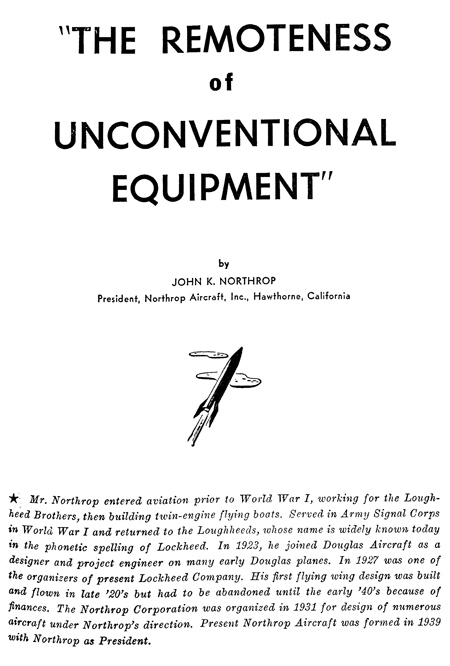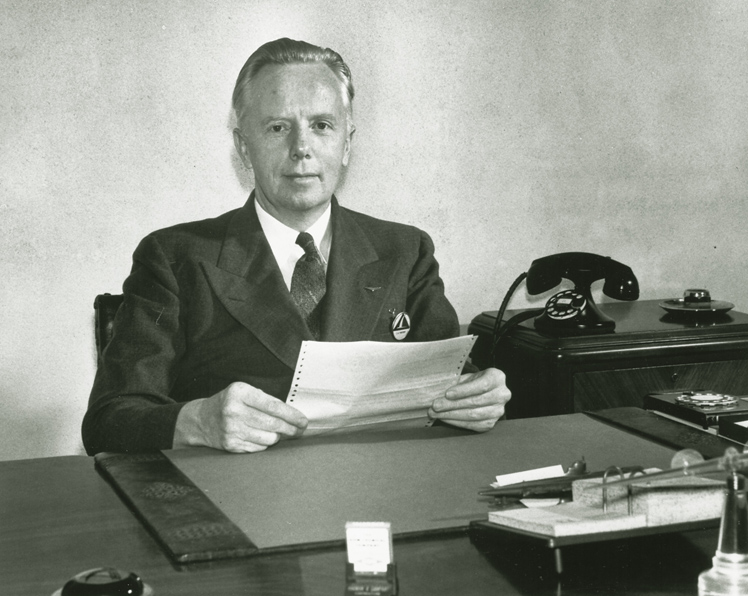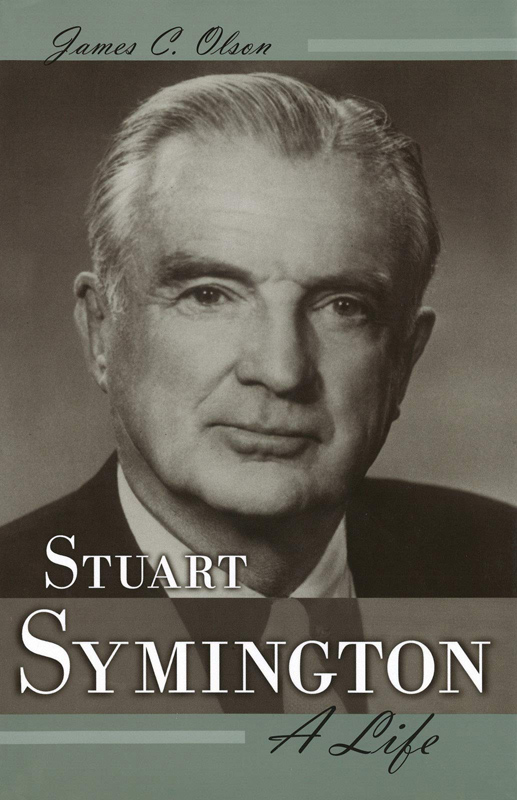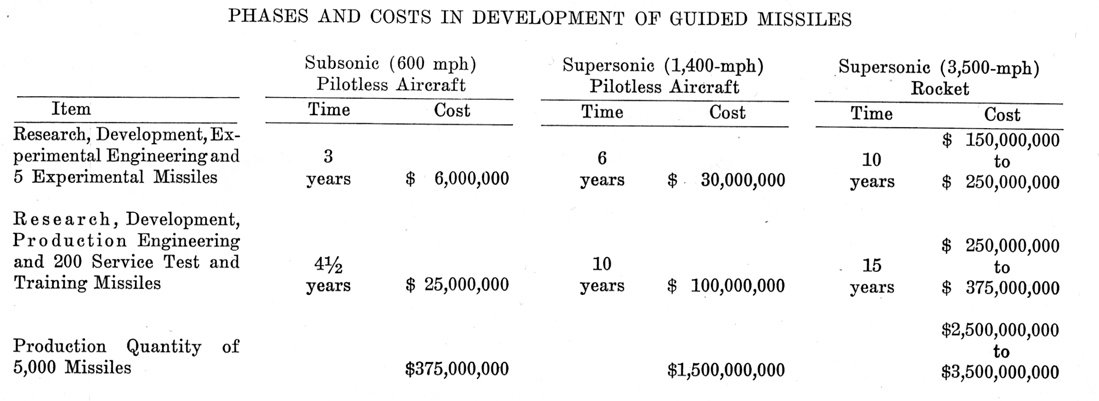In this almost prophetical paper, the founder of Northrop Aircraft Inc. foretells the challenges of push-button warfare in the thriving and complex scenario of the first years of the Cold War.
A must read for any serious enthusiast of aeronautics in the first post-wwII decade.
In questo articolo quasi profetico, il fondatore della Northrop Aircraft Inc. anticipa le sfide connesse alla guerra dei bottoni nel rigoglioso e complesso scenario dei primi anni della Guerra Fredda.
Assolutamente da leggere per ogni serio appassionato dell'aeronautica della prima decade dopo la Seconda Guerra Mondiale.
John K. Northrop on Wikipedia |
 |
John K. Northrop su Wikipedia |
 |
|
| (Above) Click on the picture above to download a PDF, English text-indexed version of the paper | (Sopra) Click sull'immagine qui sopra per scaricare una versione PDF dell'articolo, con testo inglese indicizzato |
 |
|
| (Above) John K. Northrop in 1940 | (Sopra) John K. Northrop nel 1940 |
THE REMOTENESS OF UNCONVENTIONAL EQUIPMENTBy
|
LA LONTANANZA DEGLI EQUIPAGGIAMENTI NON CONVENZIONALIDi
|
Mr. Northrop entered aviation prior to World War I, working for the Lougheed Brothers, then building twin-engine flying boats. Served in Army Signal Corps in World War I and returned to the Lougheeds, whose name is widely known today in the phonetic spelling of Lockheed. In 1923, he joined Douglas Aircraft as a designer and project engineer on many early Douglas planes. In 1927 was one of the organizers of present Lockheed Company. His first flying wing design was built and flown in late '20's but had to be abandoned until the early '40's because of finances. The Northrop Corporation was organized in 1931 for design of numerous aircraft under Northrop's direction. Present Northrop Aircraft was formed in 1939 with Northrop as President. |
Il signor Northrop è entrato nel campo aeronautico prima della prima guerra mondiale, lavorando per i fratelli Lougheed, poi costruendo idrovolanti bimotori. Ha prestato servizio nel Signal Corps dell'Esercito nella prima guerra mondiale ed è tornato alla Lougheed, il cui nome è oggi ampiamente noto nella grafia fonetica di Lockheed. Nel 1923, è entrato in Douglas Aircraft come progettista e ingegnere di progetto di molti dei primi aerei Douglas. Nel 1927 è stato uno degli organizzatori dell'attuale Lockheed Company. Il suo primo progetto di ala volante fu costruito e ha volato verso la fine degli anni '20, ma dovette essere abbandonato fino ai primi anni '40 a causa dei costi. La Northrop Corporation fu organizzata nel 1931 per la progettazione di numerosi velivoli sotto la direzione di Northrop. L'attuale Northrop Aircraft è stata costituita nel 1939 con Northrop come presidente. |
SUMMARYThree major classifications of guided missiles suitable for intercontinental warfare are briefly described and their relative characteristics discussed.
Qualified estimates of time and cost required for the production of various quantities of missiles in the different classifications are presented, and the importance of evaluating time and cost requirements in addition to technical possibilities is stressed. |
SOMMARIOTre principali categorie di missili guidati adatti per la guerra intercontinentale sono brevemente descritte e le loro relative caratteristiche sono discusse.
Vengono presentate stime qualificate dei tempi e dei costi richiesti per la produzione di varie quantità di missili nelle diverse categorie e viene sottolineata l'importanza di valutare i tempi e le esigenze di costo oltre alle possibilità tecniche. |
 |
|
| (Above) Built and flown in 1942, the JB-1 Bat test Glider is the piloted prototype of the all-wing JB series of "buzz bombs", subsequently implemented with the knowledge gained from the German V-1 (Republic-Ford JB-2). Jack Northrop was very competent on the subject of guided missiles. | (Sopra) Costruito e fatto volare per la prima volta nel 1942, l'aliante sperimentale JB-1 è il prototipo pilotato della serie di bombe volanti tutt'ala JB, successivamente implementato con il know-how ottenuto dalle V-1 tedesche catturate (Republic-Ford JB-2). Jack Northrop era molto competente sul tema dei missili guidati. |
AVAILABILITY VS. TIMEAnalysis of the remoteness, or the availability vs. time, of unconventional equipment, and an estimate of the years required to translate push-button warfare theories into practice, involves a high degree of guesswork because of the fact that little or no actual experience in such fields of endeavor is available at this time. |
DISPONIBILITÀ RISPETTO AL TEMPOL'analisi della lontananza, o della disponibilità rispetto al tempo, delle attrezzature non convenzionali e una stima degli anni richiesti per tradurre in pratica le teorie della guerra dei bottoni, comporta un alto grado di congettura, a causa del fatto che poca o nessuna esperienza effettiva in tali campi di indagine è attualmente disponibile. Per questo motivo, le stime di tempi e costi presentate nel presente documento devono essere considerate come dati qualitativi piuttosto che quantitativi. Sono stati ottenuti da personale il più qualificato possibile nelle attuali condizioni di limitata esperienza nel settore, ma possono essere ampiamente in errore, quand'anche le premesse su cui si basano non fossero variate da nuove scoperte o sviluppi. Se poi dovessero avvenire nuove scoperte relative ai campi di attività in questione, le cifre fornite potrebbero variare di diverse centinaia di per cento. |
ONLY LONG-RANGE MISSILES CONSIDEREDAt the risk of over-simplification it is assumed that unconventional equipment means guided missiles and that the only guided missiles that would justify a general translation of push-button warfare theories into practice are those able to carry at least a 5,000-pound warhead for a range of at least 4,000 miles. |
SONO CONSIDERATI SOLAMENTE I MISSILI A LUNGO RAGGIOA rischio di eccessiva semplificazione, si presume che "equipaggiamenti non convenzionali" significhi "missili guidati" e che gli unici missili guidati che giustificherebbero una messa in pratica generale delle teorie di guerra dei bottoni sono quelli in grado di trasportare almeno una testata da 2300 kg per un raggio di almeno 6500 km. |
THREE MAJOR CLASSIFICATIONSSufficient engineering analysis of the problems involved in the design, development and production of long-range guided missiles has been completed in the past two years to warrant dividing such weapons into three major classifications. These are, the subsonic pilotless aircraft, the supersonic pilotless aircraft, and the supersonic rocket. |
TRE PRINCIPALI CATEGORIENegli ultimi due anni sono state completate analisi ingegneristiche dei problemi relativi alla progettazione, allo sviluppo e alla produzione di missili guidati a lungo raggio, sufficienti a giustificare la suddivisione di tali armi in tre categorie principali. Queste sono: il velivolo subsonico senza pilota, il velivolo supersonico senza pilota e il razzo supersonico. |
SUBSONIC PILOTLESS AIRCRAFTThe first of these weapons is analogous to the German V-l buzz bomb which was used in large quantities against London and other Allied cities in World War II. The V-l had a range of about 150 miles, a high speed of 300 to 400 miles per hour, and a type of guidance which was only suitable for use against widespread target areas, even at the short distances over which it was employed. |
VELIVOLI SUBSONICI SENZA PILOTALa prima di queste armi è analoga alla bomba V-1 tedesca usata in grandi quantità contro Londra e altre città alleate nella seconda guerra mondiale. La V-l aveva un'autonomia di circa 250 chilometri, un'alta velocità da 500 a 650 chilometri all'ora e un tipo di guida che era adatto solo per l'uso contro le aree bersaglio diffuse, anche alle brevi distanze in cui era impiegato. |
 |
|
| (Above) Secretary of the Air Force Stuart Symington, according to many the man behind the demise of the B-49 - picture is linked to a short essay by Francis J. Baker "The Death of the Flying Wing : The Real Reasons Behind the 1949 Cancellation of Northrop Aircraft's RB-49", covering also the alleged perjury (subsequently confirmed by Jack Northrop himself in his last interview) in front of the congressional commission that, in 1949, investigated this case. | (Sopra) Il segretario dell'Air Force Stuart Symington, secondo molti l'uomo dietro all'insuccesso del B-49 - l'immagine è linkata a un breve saggio di Francis J. Baker "The Death of the Flying Wing : The Real Reasons Behind the 1949 Cancellation of Northrop Aircraft's RB-49", che copre anche il preteso spergiuro (successivamente confermato dallo stesso Jack Northrop nella sua ultima intervista) di fronte alla commissione di inchiesta congressuale che, nel 1949, indagò su questo caso. |
SUPERSONIC PILOTLESS AIRCRAFTThe second classification of guided missiles requires increase in the missile's speed to supersonic velocities-perhaps 1,200 to 1,400 miles per hour-through the development of airframes suitable for such speeds and the solution of the aerodynamic problems encountered. Although some progress has been made in the basic research necessary for the design and construction of such a vehicle, actual development along such lines is negligible and there is nothing on which to base hope for the early or rapid successful development of such equipment other than a very limited series of model tests. A typical idea of the problems involved may be obtained from the fact that in order to produce such a missile, it will be necessary to perfect power plants having five to ten times the thrust, and more than double the thrust per unit of frontal area, of any now running. The design and construction of such power plants, even under high priority, must of necessity involve several years of intensive work. |
VELIVOLI SUPERSONICI SENZA PILOTALa seconda categoria di missili guidati richiede un aumento della velocità del missile a velocità supersoniche - forse da 2.000 a 2.300 chilometri orari - attraverso lo sviluppo di cellule adatte a tali velocità e la soluzione dei problemi aerodinamici riscontrati. Sebbene siano stati compiuti alcuni progressi nella ricerca di base necessaria per la progettazione e la costruzione di un tale veicolo, lo sviluppo effettivo lungo tali linee è trascurabile, e non vi è nulla su cui basare la speranza di uno sviluppo precoce o rapido di tale equipaggiamento al di là di una serie molto limitata di modelli di test. Ci si può fare un'idea dei tipici problemi in gioco dal fatto che per produrre un tale missile sarà necessario portare i motori ad una spinta da cinque a dieci volte maggiore e a più del doppio della spinta per unità di area frontale, rispetto a qualsiasi motore attualmente in produzione. La progettazione e la costruzione di tali propulsori, quand'anche fosse svolta ad alta priorità, deve necessariamente comportare diversi anni di intenso lavoro. |
 (1-208).jpg) |
|
| (Above) The Northrop B-62 (TM-62) Snark intercontinental cruise missile - Jack Northrop put in practice the research and development efforts described in this paper, written in the last months of 1947. Work on the Snark began in 1946. | (Sopra) Il missile da crociera intercontinentale Northrop B-62 (TM-62) Snark - Jack Northrop mise in pratica gli sforzi di ricerca e sviluppo descritti in questo articolo, scritto negli ultimi mesi del 1947. Il lavoro sullo Snark era iniziato sin dal 1946. |
SUPERSONIC ROCKETSThe third type of guided missile that must be considered is the supersonic rocket. This vehicle is exemplified by the V-2 developed by the Germans during the war for the attack on London. The V-2 effort was one of the outstanding technical accomplishments of World War II, requiring approximately six years to complete, and an estimated outlay of the equivalent of $250,000,000. When it is considered that the maximum range of the V-2 was about 200 miles and the accuracy attained permitted only general bombing of large areas at short range, it may be realized that a tremendous amount of research and development is necessary before a suitable long-range rocket with proper guidance can possibly be obtained. |
RAZZI SUPERSONICIIl terzo tipo di missile guidato da considerare è il razzo supersonico. Questo veicolo è esemplificato dalla V-2 sviluppata dai tedeschi durante la guerra per l'attacco a Londra. Il progetto V-2 è stato uno degli eccezionali risultati tecnici della Seconda Guerra Mondiale, che ha richiesto circa sei anni per essere completato, e un esborso stimato equivalente a duecentocinquanta milioni di dollari. Quando si considera che il raggio massimo della V-2 era di circa 350 chilometri e che l'accuratezza raggiunta consentiva solo bombardamenti generali su vaste aree a corto raggio, ci si può rendere conto che è necessaria un'enorme quantità di ricerca e sviluppo prima di ottenere un razzo a lungo raggio con un sistema di guida adeguato. |
RELATIVE VALUE OF VARIOUS TYPESIn determining and comparing the values of the three types of guided missiles briefly described above, it is necessary to consider many characteristics of each which cannot even be outlined in a paper of this scope, let alone properly evaluated. Space permits the mention of only a few of the most important, namely, time of development and production, cost of development and production, degree of accuracy to be expected, and relative ease of interception by an enemy. |
VALORE RELATIVO DEI DIVERSI TIPINel determinare e confrontare i valori dei tre tipi di missili guidati brevemente descritti sopra, è necessario considerare molte caratteristiche di ciascuno che non possono nemmeno essere delineate, e meno che meno adeguatamente valutate, in un documento di questa dimensione. Lo spazio consente di menzionare solo alcuni dei più importanti elementi, vale a dire il tempo di sviluppo e produzione, i costi di sviluppo e produzione, il grado di accuratezza da aspettarsi e la rispettiva facilità di intercettazione da parte di un nemico. |
TIME AND COST CONSIDERATIONSMany articles and discussions of the relative merits of aircraft and guided missiles, as well as the various types of guided missiles, concern themselves solely with the technical possibilities and completely neglect two essential considerations. The first of these is the time required for the perfection of such a potentially valuable new weapon. The second is the relative cost thereof. |
CONSIDERAZIONI DI TEMPO E COSTOMolti articoli e discussioni sui meriti relativi dei missili aerei e guidati, così come i vari tipi di missili guidati, si preoccupano unicamente delle possibilità tecniche e trascurano completamente due considerazioni essenziali. La prima di esse è il tempo richiesto per il perfezionamento di una nuova arma così potente e di valore. Il secondo è il relativo costo della stessa. |
.jpg) |
|
| (Above) The Northrop B-62 (TM-62) Snark intercontinental cruise missile - in the wind gallery. | (Sopra) Il missile da crociera intercontinentale Northrop B-62 (TM-62) Snark - nella galleria del vento. |
QUALIFICATION OF ESTIMATESBased on limited information available at this time, and subject to the many qualifications outlined above, we have endeavored to summarize time and cost estimates for the development of the three categories of guided missiles described. The estimates cover three necessary steps in the quantity procurement for wartime use of such weapons. The first step is the research and development required for the production and test of five experimental missiles. The second step includes the first, plus the manufacture and launching of a service test and preliminary training quantity totaling 200 missiles, which number might be inadequate in the case of rockets. The final step is the production of 5,000 missiles. |
CRITERI DI STIMASulla base delle informazioni limitate disponibili in questo momento e in base ai numerosi criteri sopra delineati, ci siamo sforzati di riassumere le stime di tempi e costi per lo sviluppo delle tre categorie di missili guidati sopra descritti. Le stime coprono tre passaggi necessari per l'approvvigionamento delle quantità necessarie per l'uso bellico di tali armi. Il primo passo è la ricerca e lo sviluppo necessari per la produzione e il test di cinque missili sperimentali. Il secondo passo include il primo, oltre alla produzione e al lancio di un test di servizio e una quantità di addestramento preliminare per un totale di 200 missili, il cui numero potrebbe essere inadeguato nel caso dei missili. Il passo finale è la produzione di 5.000 missili. |
 |
|
| (Above) PHASES AND COST IN THE DEVELOPMENT OF GUIDED MISSILES | (Sopra) FASI E COSTI NELLO SVILUPPO DI MISSILI GUIDATI |
PUBLIC DANGEROUSLY OVERSOLDFrom the information now available we are forced to conclude that the general public has been greatly oversold on the possible imminence of push-button warfare, and that even if we select the simplest and cheapest program of development, about five years would elapse under peacetime conditions before it would be possible to make available sufficient guided missiles to be used as effective weapons in intercontinental war. Under the stimulus of wartime conditions it is possible that the time required could be reduced somewhat below the estimates given, but in any program of production of a new type weapon the days at the start of the program are just as important as those at the end. Therefore it is vital that a decision be reached promptly and pursued vigorously if we are to achieve even the estimated timing. The idea that push-button warfare of any type could be used for any purpose within months, or even two to five years, is a dangerous fallacy that must not be allowed to interfere with the availability of existing and improved military equipment of conventional types. |
IL PUBBLICO È VITTIMA DI UNA PERICOLOSA SOPRAVVALUTAZIONEDalle informazioni ora disponibili siamo costretti a concludere che il pubblico generale è stato portato a sopravvalutare notevolmente la possibile imminenza della guerra dei bottoni, e che anche se selezionassimo il programma di sviluppo più semplice ed economico, circa cinque anni dovrebbero passare in condizioni di pace prima che fosse possibile rendere disponibili missili guidati sufficienti per essere usati come armi efficaci nella guerra intercontinentale. Sotto lo stimolo delle condizioni di guerra, è possibile che il tempo richiesto possa essere ridotto un po' al di sotto delle stime fornite, ma in qualsiasi programma di produzione di un nuovo tipo di arma i giorni all'inizio del programma sono altrettanto importanti di quelli alla fine. Pertanto è fondamentale che una decisione venga raggiunta tempestivamente e perseguita vigorosamente se mai vogliamo rispettare i tempi stimati. L'idea che una guerra dei bottoni di qualsiasi tipo possa essere utilizzata per qualsiasi scopo entro pochi mesi, o anche da due a cinque anni, è un errore pericoloso, a cui non deve essere permesso di interferire con la disponibilità di equipaggiamenti militari esistenti e migliorati di tipi convenzionali. |
GUIDED MISSILES A SUPPLEMENTWhen guided missiles come into use as effective intercontinental weapons it can only be expected that they will supplement more thoroughly proved types of equipment. An extensive period of active use after the time of their introduction in any conflict must be planned before they could be expected to form the major backbone of our offensive equipment. We must recognize that there is as much opportunity for improvident in guided missiles as there is in aircraft, and at all cost avoid a "Maginot Line" philosophy which would permit complacent reliance on the earlier types that may be built. It is essential that research and development continue on high priority in this largely unexplored field if any semblance of security is to be maintained. |
I MISSILI GUIDATI: UN SUPPLEMENTOQuando i missili guidati entrano in gioco come armi intercontinentali efficaci, ci si può aspettare che complementino tipi di equipaggiamento più convenzionali. Si deve pianificare un lungo periodo di uso attivo dopo il momento della loro introduzione in qualsiasi conflitto, prima di poter prevedere che essi costituiscano la spina dorsale principale della nostra attrezzatura offensiva. Dobbiamo riconoscere che ci sono tante opportunità di miglioramento nei missili guidati come negli aerei, e ad ogni costo evitare una filosofia della "linea Maginot" che tolleri il consolidarsi di un compiacente affidamento sui tipi di armi precedenti. È essenziale che la ricerca e lo sviluppo continuino ad avere una priorità elevata in questo campo in gran parte inesplorato, se si vuole mantenere una parvenza di sicurezza. |
ADVANTAGES OF GUIDED MISSILESA few of the important advantages inherent in their use are as follows: |
VANTAGGI DEI MISSILI GUIDATIAlcuni degli importanti vantaggi inerenti al loro utilizzo sono i seguenti: |
QUALIFICATIONS OF GUIDED MISSILESAt least in the early stages of their use, guided missiles having the necessary range for intercontinental warfare cannot be expected to achieve usefulness against pin-point targets such as bridges, individual factories, etc. They can be extremely useful for attack on industrial areas, however, with explosive, incendiary, biological or atomic warheads. There is no particular reason why they cannot be developed in sizes to carry warheads two or three times the weights assumed earlier in this paper. |
CRITERI D'IMPIEGO DEI MISSILI GUIDATIAlmeno nelle prime fasi del loro utilizzo, non ci si può aspettare che i missili guidati con il raggio necessario per la guerra intercontinentale siano usabili contro bersagli puntuali come ponti, singole fabbriche, ecc. Possono essere estremamente utili per attaccare aree industriali, tuttavia, con testate esplosive, incendiarie, biologiche o atomiche. Non vi è alcun motivo particolare per cui non possono essere sviluppati in dimensioni adatte per trasportare testate di peso doppio o triplo di quello considerato in questo documento. |
❦